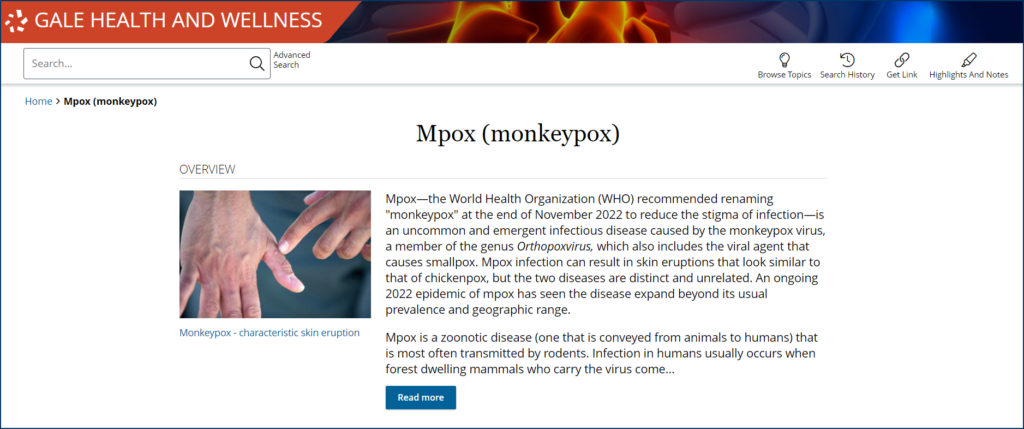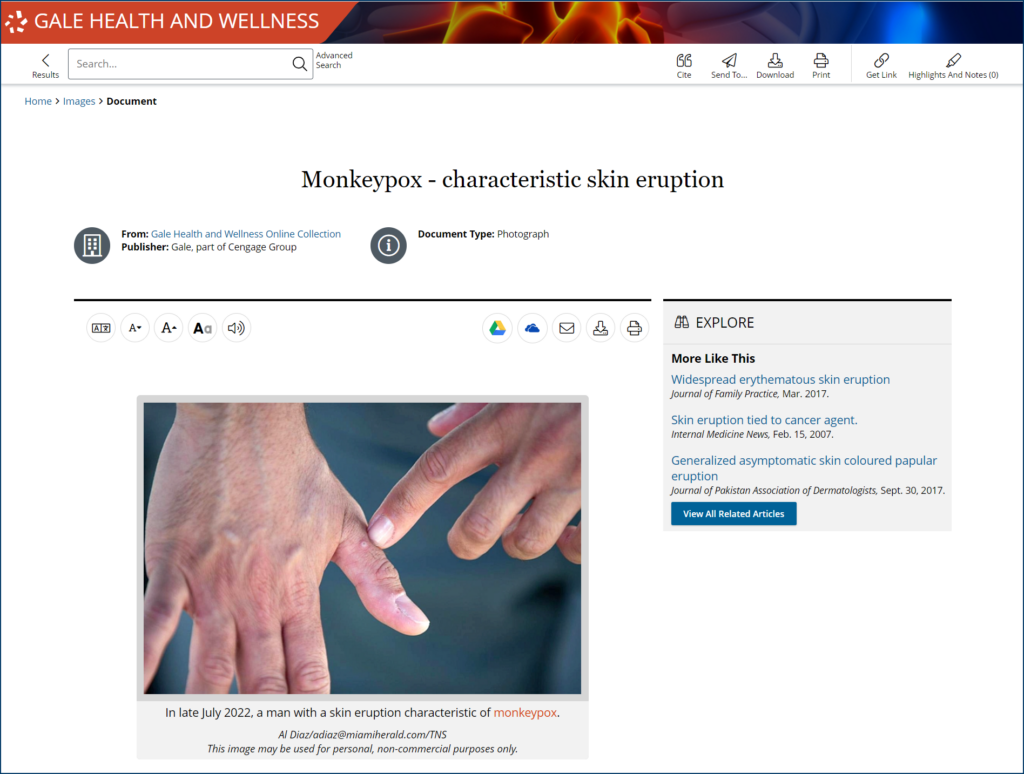| By Gale Staff |
Globalization has brought countless benefits, connecting people, cultures, and economies. However, this unprecedented level of interconnectedness also brings new challenges, including the swift spread of diseases from one part of the world to another. Such is the case with mpox—previously called monkeypox—as a recent variant emerged in Sweden in August, with suspected infections aboard a cargo ship in Argentina leading to it being quarantined around the same time. This marks the second outbreak in as many years.

These cases were announced just days after the World Health Organization (WHO) declared a “public health emergency of international concern” regarding the outbreak of mpox in Burundi, the Democratic Republic of the Congo (DRC), Kenya, and other African nations.
With the COVID-19 pandemic still fresh in our minds, the public is acutely aware of the potential danger of the growing mpox epidemic. As people turn to libraries—academic and public—to navigate the flood of information, Gale is here to partner with you to keep your patrons informed.
Gale Health and Wellness ensures your library delivers up-to-date content from authoritative sources, including reference materials, magazine and journal articles, news outlets, and multimedia. We’ll introduce you to examples of these resources available on the mpox topic portal, a user-friendly interface for accessing materials that are updated daily.
Informational Resources for Mpox Basics
When people search for information about diseases and medical conditions, they need concise, reliable guidance on the illness, its symptoms, and how it might affect them.
Gale Health and Wellness streamlines their research, compiling the information above the fold of each topic portal page. This layout lets users quickly grasp the crux of the information before digging into the more in-depth resources that cover a virus’s history, impact on public health, and the context behind a particular wave or resurgence.
Let’s look at how Gale’s resources provide insights and information about the basics of mpox.
What Is Mpox?
Mpox is an infectious disease caused by the Orthopoxvirus, a genus that also includes cowpox and smallpox (variola) viruses. Its previous name, monkeypox, harkens back to its first noted appearance in 1958 when monkeys in Copenhagen developed a rash that looked similar to smallpox.
Over the decade that followed, more outbreaks occurred across monkey colonies, but the first human case didn’t appear until a child in the DRC caught mpox in September 1970.
How Does Mpox Spread?
Like many viruses, mpox spreads through close contact with a person or animal that is currently infected, primarily through body fluids and lesions. However, the virus can also be transmitted through fabric, such as clothing and bedding, which adds more complexity to containing outbreaks.
What Are the Signs and Symptoms?
The first signs of an Orthopoxvirus infection typically appear within 21 days of initial exposure. Still, at first glance, its manifestation resembles countless other illnesses, including chickenpox: fever, headache, muscle pain, swollen lymph nodes, and fatigue. This delayed onset and symptom mimicry is primarily why the contagion spreads so quickly.
It’s not until the distinctive rash appears 1–3 days later that it differentiates itself physically. The raised lesions usually appear on the face first, then spread to the trunk and extremities before finally reaching the palms and soles. The lesions then fill with fluid and pus until they form a crust. The process, from initial lesion to crusting, takes 2–4 weeks.

Are There Any Known Mpox Treatments?
Unlike its deadly cousin, smallpox, mpox typically resolves on its own without the need for specific treatment. However, for those who are more likely to develop complications, such as children and immunocompromised individuals, doctors might consider antiviral medications like tecovirimat.
A Brief History of Mpox Cases in the United States
Records of previous outbreaks available through Gale Health and Wellness provide context for the current situation, demystifying the virus and, hopefully, reducing fear with quantitative data. In academic settings, that data also presents an opportunity for students studying fields like public health or virology to observe patterns of zoonotic transmission and their implications for global health security.
2003
In 2003, the United States experienced its first mpox outbreak, linked to a shipment of 800 small mammals imported from Ghana. The infection spread to prairie dogs being sold as pets, passing the infections on to humans across six states: Illinois, Indiana, Kansas, Missouri, Ohio, and Wisconsin. The first diagnosed case was that of a 3-year-old after a prairie dog bit her on the finger. All said, there were 22 suspected, 12 probable, and 37 confirmed cases linked to this instance of the exotic pet trade gone wrong.
2018–2021
From 2018 to 2021, there were seven reported cases of the Nigerian strain of mpox in non-African countries, including two in the United States. Leading up to 2018, Nigeria had gone nearly four decades without a human diagnosis.
In July 2021, a Texas resident who had recently traveled to Nigeria was diagnosed with the virus. In November of that same year, a Maryland resident also contracted mpox after returning from Nigeria. In their report on the July case, the Morbidity and Mortality Weekly Report noted, “Fortuitously, mask use during the ongoing COVID-19 pandemic ensured that contacts, including fellow airline passengers and crew members, community contacts, and health care providers, were at reduced risk for being infected with Monkeypox virus from this patient.”
2022
In 2022, mpox made headlines with a major outbreak that resulted in 99,518 global diagnoses, 207 deaths, and a mortality rate of 2 in every 1,000 people. The highest incidence rate was in the United States, with 33,435 cases. However, the mortality was below the global rate, with 60 deaths and 1.8 deaths per 1,000 infections.
This widespread transmission across multiple continents demonstrated how quickly a once-localized virus could escalate into an international public health concern.
The 2024 Mpox Outbreak: News and Resources
With mpox cases in Africa soaring by 160% this year and over 15,000 infections resulting in more than 460 deaths as of August 14, 2024, concerns exist over a possible pandemic. As this virus crosses borders and enters new regions, the need for accurate, reliable information becomes ever more critical.
For patrons interested in tracking the most recent news regarding the 2024 mpox outbreak, Gale Health and Wellness is a one-stop shop for unbiased information published in medical journals, such as the CDC’s peer-reviewed Emerging Infectious Diseases, and globally trusted healthcare periodicals, including Health and Medicine Week, Consumer Health News, and more.
To access these daily updates via the mpox topic page, users need only select the “News” resource category to access a chronologically ordered list of articles.
To help patrons use these resources to learn about mpox and other medical news, here are a few tips for librarians to bring attention to them:
- Set up a display with instructional printouts or QR codes linking directly to the mpox portal on Gale Health and Wellness.
- Connect with your patrons on social media, letting them know that your library offers up-to-date, reliable information on mpox, how to prevent its spread, and how it might impact their lives. This strategy can help your resources reach a broader audience, especially for those who may not visit the library in person.
- If your library sends a digital newsletter, include a section dedicated to current health issues with linked resources such as the mpox global case map.
Strengthening Community Health Through Knowledge
People rely on their libraries for guidance in times of uncertainty. With a subscription to Gale Health and Wellness, you can provide a source of support that encourages patrons to cut through the noise and find the facts they need.
If you want to learn more about what Gale Health and Wellness offers for public library patrons and academics, we encourage you to learn more.

